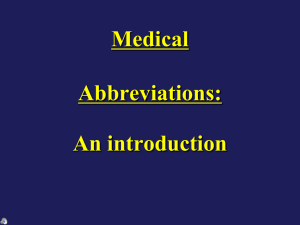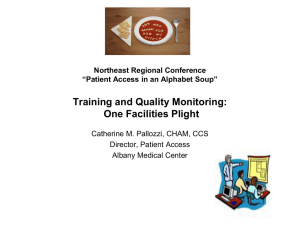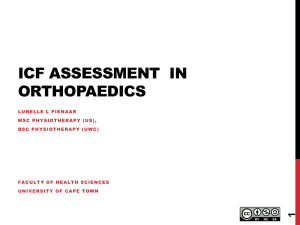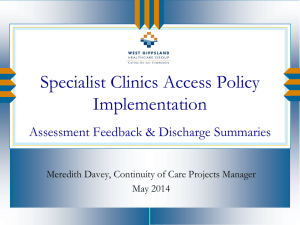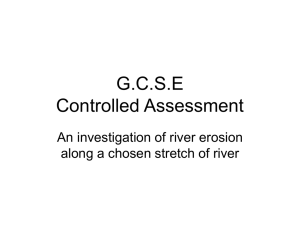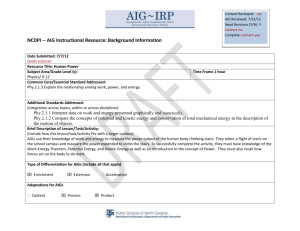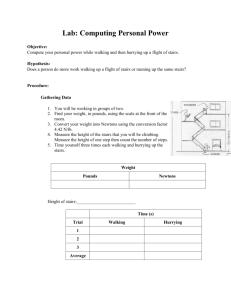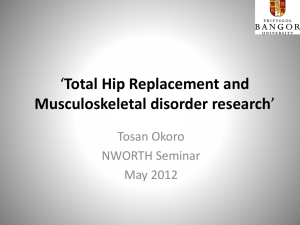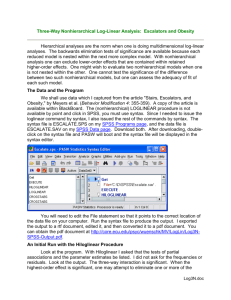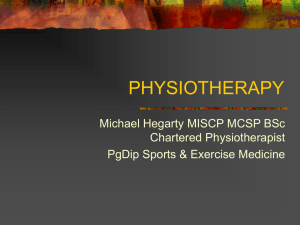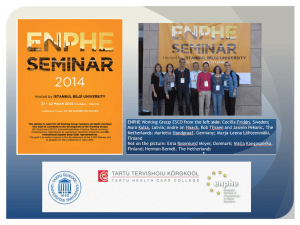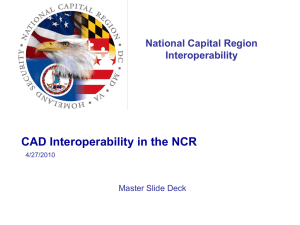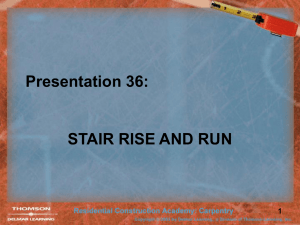Clinical documentation
advertisement
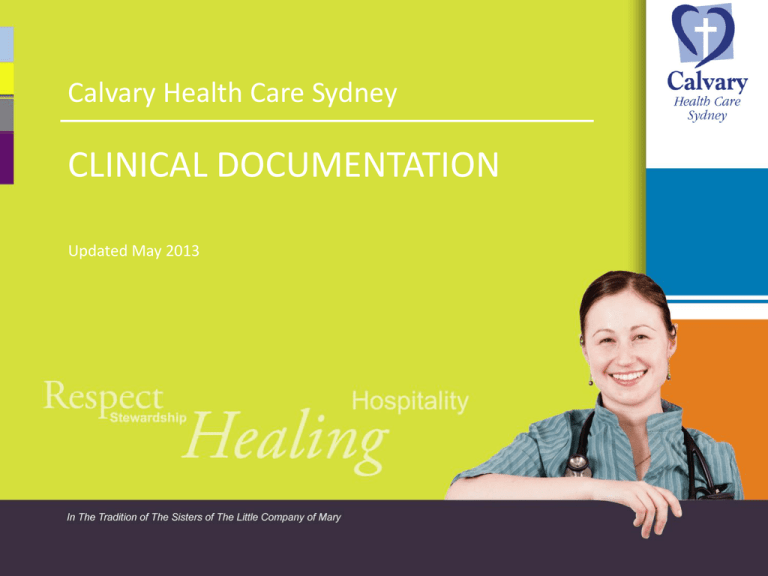
Calvary Health Care Sydney CLINICAL DOCUMENTATION Updated May 2013 WHO Guidelines for Medical Record & Clinical Documentation WHO Guidelines for Medical Record & Clinical Documentation • Documentation and record keeping is a fundamental part of clinical practice. It demonstrates the clinician’s accountability and records their professional practice. • Documentation is the basis for communication between health professionals that informs of the care provided, the treatment and care planned and the outcome of that care as a continuous and contemporaneous record. WHO Guidelines for Medical Record & Clinical Documentation • Documentation is a record of the care and the clinical assessment, professional judgement and critical thinking used by a health professional in the provision of that care. • Documentation must be patient focused and based on professional observation and assessment that does not have any basis in unfounded conclusions or personal judgements. WHO Guidelines for Medical Record & Clinical Documentation • Documentation is often used to evaluate professional practice as a part of quality assurance mechanisms such as performance reviews, audits and accreditation processes, legislated inspections and critical incident reviews. • Documentation systems should promote appropriate sharing of information amongst the multidisciplinary teams. • Accurate and comprehensive documentation is a valuable source of data for data coding, health research and a valuable source of evidence and rationale for funding and resource management. WHO Guidelines for Medical Record & Clinical Documentation • Documentation should record both the actions taken by clinical staff and the patient’s needs and/or their response to illness and the care they receive. • It should be assumed that any and all clinical documentation will be scrutinised at some point. WHO Guidelines for Medical Record & Clinical Documentation 5 Mandatory Pieces of Information • • • • Date Time (24hr) Name of therapist Designation (e.g. Physiotherapist, Physiotherapy student) • Signature Writing in Clinical Notes • Patient identification sticker in the top right hand corner – If missing you must write the patients name, MRN and DOB. • A physiotherapy sticker is placed at the beginning of the entry or written if unavailable. • Name of clinician should be clearly written next to the physiotherapy sticker and (Yr xx Student) • The full date and 24 hour time on each entry in the left hand column • All entries are written using BLACK ink only. • Writing must be legible and kept within the margins of the page • Each entry must be signed on the final line and countersigned by your supervisor Writing in Clinical Notes • Be aware that other people may wish to view the records at the same time as you especially with new patient’s notes. Place all notes back in the designated area after they have been viewed or written in. • You should check every one of your patient’s notes in the morning before seeing them so you are informed of any changes that may have taken place overnight which affects your treatment. • Medical records must be completed within 24hours of seeing the patient. An entry is classified as late if entered on the next rostered shift. Any late entry is identified as a ‘late entry’ with the date and time of entry noted. Write what you see… • Documentation must be based on professional observation and assessment. • Write what you see, not what you think you see. • The person who performed, observed or heard an event or treatment makes all entries. No entry is made for anyone else. • An entry should be accurate, brief and complete. • Reference should also be made where a patient refuses any treatment or acts contrary to advice. • The meaning of a medical term is used in the correct context and meaning is correct. • Language used is uncomplicated and easy to understand to assist all health professionals reading the record. Writing in Clinical Notes Any errors made while writing an entry in a patient’s medical record should be dealt with by drawing a line through the incorrect entry and initialling it before continuing on. No space is to be left within or between entries, which would enable words to be added. If there are any blank spaces a line is drawn through them. • Any entry that continues over the page has the date and ‘continued’ (cont’d) documented. • The word ‘addit’ is written if additional information to a clinical record entry is made immediately after a previous entry by the same person. The date and time is also written and then signed off. • Only official abbreviations, symbols and acronyms are used as per CHCS abbreviations policy and “The Australian Dictionary of Clinical Abbreviations and Symbols” published by the HIMMA. Writing in Clinical Notes • For every patient entry you should include: - Subjective assessment (S/) - Objective assessment (O/) - Treatment provided (Rx/) and re-assessment (//) if any changes occurred as a result of treatment - Treatment plan (P/) • If you see a patient twice a day you have to refer to the two occasions of service. Treatment Documentation Example Rx: • Mobilised outdoors to bus stop and back, plus half way to bus stop and back (~300m) a/a // occasional prompting required to maintain step length on left. Client sometimes unable to clear prosthetic foot so toe drags on pavement increasing falls risk. Client still requires supervision with outdoor mobility • Sideways stepping along kitchen bench x10 hands close together // step length reduces when client places hands together • Stepping with left foot and only right hand support 4x5 // requires prompting to "stand tall and stay strong" to assist in stabilising hip on prosthesis • Standing balance with reaching to forward target and keeping right hip next to bench // has difficulty completely WBing on prosthesis but improved with prompting • Left in prone with towel under stump for hip flexor stretch Aiding Clinical Handover • Another physio should be able to read your notes and replicate treatment. – What was done? – Where? – How many times? For how long? – How much help? – Patient response to Rx? THE INITIAL ASSESSMENT The Initial Assessment Introduce yourself and what you will be doing as a physio/student. History of Presenting Illness (HPI): • The history of the current complaint. (When? How? Lead up?) • What has been done to date (e.g. investigations, surgery, other treatment) Past Medical History (PMHx): • Other medical conditions the patient has especially the ones that will guide or affect your treatment approach. Try and provide dates. The Initial Assessment cont. Social History (SHx): • Living arrangements, (type, stairs/rails, modifications). • Presence of family/carer, family members; support provided. • Social services, social activities and access to the community. Pre-morbid Level of Function: • Need to get an idea what their functional level was prior to hospitalisation. How far could they walk? What walking aid? Limiting factor? • Were they housebound or could they access the community? • Could they walk stairs/outdoors? • Falls history- how many?, injuries sustained?, how did they occur? could they get up, how long did they lie there? The Initial Assessment cont. Subjective Assessment (S/): • Should only include what the patient tells you, no assumptions or judgements. Objective Assessment (O/): • Bed Mobility- including moving across and up the bed and rolling and in and out of bed. • Sit to stand- height of chair, use of upper limbs. • Transfers- bed to chair/chair to bed. • Mobility: – Assistance/aids required – Quality of movement including step length, base of support, hip/knee extension, gait pattern (step to/step through/shuffling gait). • Pain 0-10 (rest and mobilising). • Strength and range of motion of affected joints. The Initial Assessment cont. Goals: • Short term and long term goals should be set. • Usually the long term goal will be the discharge goal and the short term goals should be related to the objective measures. Objective Assessment in gym: • More thorough assessment of strength and ROM. • Outcome measures (e.g.) – – – – 3MWT Tinetti Berg TUG Case Conference Reporting For the patients first Case Conference report their pre morbid physical functioning i.e. mobility aid, community access, falls Hx, exercise tolerance. Patients motivation/ gym attendance/ any behavioural/pain issues. Bed Mobility: Amount of assistance required Height of bed Sit to Stand: Amount of assistance required Quality of performance Height of chair Case Conference Reporting Mobility Status: • Walking aid • Independent/supervision/assistance • Distance • Limiting factors • Quality of gait Stairs: (particularly if the patient has stairs at home) • Comment on the patient’s ability to negotiate stairs mimicking home – e.g. number of rails, number of stairs, assistance required Case Conference Reporting Outcome Measures: • E.g. 3MWT, Tinetti, BBS, TUG Time Frames: • In terms of achieving short term and long term goals, home visit, discharge Discharge: • Towards discharge consider if any referrals for physiotherapy are required • Raise any potential barriers to discharge Other: • Report patients at risk of falling so staff increase alertness • Any other issues pertinent to the particular patient and their rehabilitation including discussions with the patient and their families Some Abbreviations ADL - activities of daily living Q/S – Quadstick BOS - Base of support RF – Rollator frame Bro – Brother SIL –sister in law BIL – Brother in Law SNAP – sub and non acute patient classification system B/T – Break-through medication CPCT – Community Palliative Care Team TUG – Timed up and go DIL – Daughter in Law 2wrf –two wheeled rollator frame FIVD – fixed interval variable dose 4wrf –four wheeled rollator frame GAS – Goal attainment scaling 3MWT –three minute walk test G’mo – Grandmother // bars – parallel bars G’fa – Grandfather // - re-assessment H/care – homecare X –Exercise



